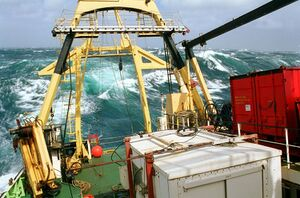Offshore operations - history, British Geological Survey

Introduction to offshore operations in BGS
The following are excellent introductions to offshore operations in BGS:
On the shelf: geology beneath the waves - MediaWiki (bgs.ac.uk)
Fannin, N G T. 1989. Offshore investigations 1966-87. British Geological Survey Technical Report WB/89/2.
People
Robert Arthur Eden - Laid the foundations for offshore operations and geological mapping of the UK continental shelf.
Dennis Ardus Dennis Alexander Ardus, 1937-2008.
Ships
An alphabetical list of ships that have been used in offshore operations can be found at: Ships - alphabetical list of ships used in BGS offshore operations
Timeline
| Date | Event |
|---|---|
| Airborne magnetometer lines for land areas of the United Kingdom. Captures some adjacent offshore areas | |
| 1966 | Geophysical Department undertook some follow up work on anomalies revealed by the above airborne magnetometer lines in Loch Ewe in western Scotland and in the Moray Firth using a towed magnetometer and a shallow seismic profiling system. |
| R A Eden and J D Peacock, both enthusiastic scuba divers from the Edinburgh Office, undertook sea-bottom sampling and coring with self-contained diving equipment. | |
| 1966 | Programme of curation and correlation of records and samples from commercial hydrocarbon exploration boreholes in the North Sea, on behalf of the Ministry of Fuel and Power, initiated by two members of the Yorkshire and East Midlands Field Unit. |
| 1967 | Formation of a Continental Shelf Unit I in Leeds, to study the southern North Sea and the Irish Sea. |
| 1967 | Continental Shelf Unit I at Leeds started work on a bottom-sampling programme in the Irish Sea |
| 1967 | Nucleus of a Continental Shelf Unit II created at the end of the year in Edinburgh as part of the South Lowlands Field Unit |
| 1967–1968 | Reconnaissance survey work began in the Irish Sea and continued in 1968 |
| 1968 | Geophysical Division, took part in a sedimentological investigation of the Humber estuary, planned by the Humber Estuary Research Committee, which included representatives of the Humber Conservancy Board, British Transport Docks Board and Hydraulics Research Station. |
| 1968 | Marine Geophysics Unit formed from part of the Geophysical Division |
| 1969 | Continental Shelf Unit II established as separate unit based at Granton. |
| 1969 | Work in the Firths of Clyde and Forth and in the Sea of the Hebrides by Continental Shelf Unit II |
| 1969 | Association with MV Whithorn began and Continental Shelf Unit I and II began systematic sampling programme on the sea floor around the UK. |
| 1974 | Continental Shelf Unit I and II transferred from the Field Divisions to the Geophysics Division became Continental Shelf and Geophysical Division. |
| 1976 | Continental Shelf Units I and II and the Marine Geophysics Unit were reformed as the Continental Shelf Division under John Wright. |
| 1979 | Two principal programmes established to support Department of Energy requirements.
1. BGS Hydrocarbons Programme. Collation, curation and interpretation of seismic data, cores and samples supplied by the licencees to DEn under the Petroleum and Pipelines Act (1975) and related legislation. 2. Regional Mapping Programme (RMP) Marine Geology Programme and the Marine Geophysics and Offshore Services Programme. The direct acquisition of data, leading to the preparation and publication of a series of geological and geophysical maps and associated reports of the UK offshore area. |
| 1980 | Continental Shelf Unit I and II amalgamated into the new Marine Geology Unit, still based at Leeds and Edinburgh. |
| 1982 | Marine Geology Unit took over the whole of Grange Terrace building in Edinburgh. |
Key published results
United Kingdom Offshore Regional Reports
A series of eleven regional reports that describe the offshore geology of the United Kingdom. They complement the Regional Geology Guides which cover the onshore areas. They cover all aspects of the geology, from the most recent formed sediments to the deep structure of the crust and include a chapter on economic geology. Most were published between 1990 and 1995.
1:250 000 UTM Series. Geological maps of the UK and continental shelf areas
Solid geology, Quaternary geology and sea-bed sediment maps of the UK and continental shelf. The series started in 1977 and superseded the 'Quarter-inch' maps of England and Wales and of Scotland.
Aeromagnetic 1:250 000 UTM Series. Aeromagnetic anomaly maps of the UK and continental shelf areas
Illustrate small departures from the expected values of the earth's magnetic field caused by the variations in the magnetisation of the rocks within the earth's crust. Maps were issued 1977–1990.
Bouguer 1:250 000 UTM Series. Bouguer anomaly maps of the UK and continental shelf areas
Illustrate small departures from the expected values of the earth's gravity caused by the variations in the density of the rocks within the earth's crust. Maps were issued 1975–1989.
Free air 1:250 000 UTM Series. Free air anomaly maps of the UK and continental shelf areas
A small number of Free-air anomaly maps were produced. They are the measured gravity anomaly after a free-air correction is applied to correct for the elevation at which a measurement is made compared with Sea Level. Maps were issued 1981–1989.